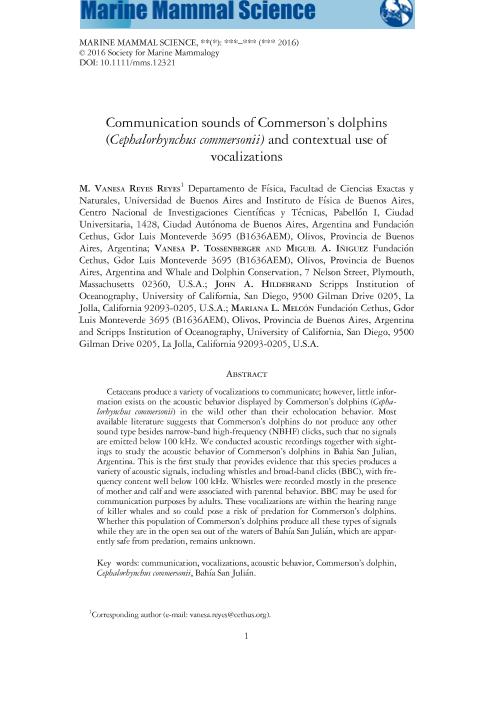Artículo
Communication sounds of Commerson?s dolphins (Cephalorhynchus commersonii) and contextual use of vocalizations
Reyes Reyes, María Vanesa ; Tossenberger, Vanesa; Iñíguez, Miguel; Hildebrand, John; Melcon, Mariana Laura
; Tossenberger, Vanesa; Iñíguez, Miguel; Hildebrand, John; Melcon, Mariana Laura
 ; Tossenberger, Vanesa; Iñíguez, Miguel; Hildebrand, John; Melcon, Mariana Laura
; Tossenberger, Vanesa; Iñíguez, Miguel; Hildebrand, John; Melcon, Mariana Laura
Fecha de publicación:
10/2016
Editorial:
Wiley Blackwell Publishing, Inc
Revista:
Marine Mammal Science
ISSN:
0824-0469
Idioma:
Inglés
Tipo de recurso:
Artículo publicado
Clasificación temática:
Resumen
Cetaceans produce a variety of vocalizations to communicate; however, little information exists on the acoustic behavior displayed by Commerson?s dolphins (Cephalorhynchus commersonii) in the wild other than their echolocation behavior. Most available literature suggests that Commerson?s dolphins do not produce any other sound type besides narrow-band high-frequency (NBHF) clicks, such that no signals are emitted below 100 kHz. We conducted acoustic recordings together with sightings to study the acoustic behavior of Commerson?s dolphins in Bahia San Julian,Argentina. This is the first study that provides evidence that this species produces a variety of acoustic signals, including whistles and broad-band clicks (BBC), with frequency content well below 100 kHz. Whistles were recorded mostly in the presence of mother and calf and were associated with parental behavior. BBC may be used for communication purposes by adults. These vocalizations are within the hearing range of killer whales and so could pose a risk of predation for Commerson?s dolphins. Whether this population of Commerson?s dolphins produce all these types of signals while they are in the open sea out of the waters of Bahıa San Julian, which are apparently safe from predation, remains unknown.
Palabras clave:
Vocalizations
,
Acoustic Behaviour
,
Commerson'S Dolphins
,
Bahia San Julian
Archivos asociados
Licencia
Identificadores
Colecciones
Articulos(IFIBA)
Articulos de INST.DE FISICA DE BUENOS AIRES
Articulos de INST.DE FISICA DE BUENOS AIRES
Citación
Reyes Reyes, María Vanesa; Tossenberger, Vanesa; Iñíguez, Miguel; Hildebrand, John; Melcon, Mariana Laura; Communication sounds of Commerson?s dolphins (Cephalorhynchus commersonii) and contextual use of vocalizations; Wiley Blackwell Publishing, Inc; Marine Mammal Science; 32; 4; 10-2016; 1219-1233
Compartir
Altmétricas



